Native
Gypsonoma haimbachiana (Kearfott) (Tortricidae: Olethreutinae: Eucosmini)
Common name: cottonwood twig borer moth
FWL: 5.5-7.5 mm
Head, thorax pale to dark gray; basal third of FW concolorous with thorax, sometimes with a darker patch along inner margininner margin:
see dorsum 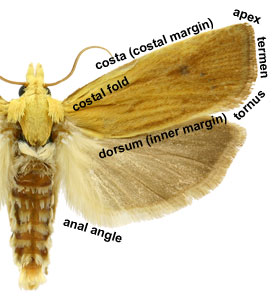 ; distaldistal:
; distaldistal:
farthest from body, distant from point of attachment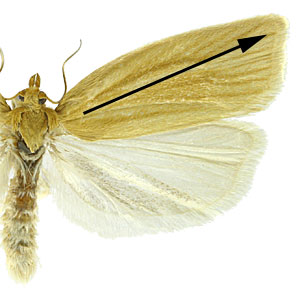 two-thirds of forewing pale gray to white, occasionally suffused with tan scaling; ocellusocellus:
two-thirds of forewing pale gray to white, occasionally suffused with tan scaling; ocellusocellus:
forewing pattern element - an ovoid region anterior to the tornus; adult head - a simple insect "eye" located dorsal to the compound eye 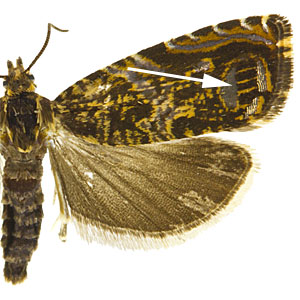 variously defined, typically faint; a black semi-circle present at apexapex:
variously defined, typically faint; a black semi-circle present at apexapex:
the point furthest removed from the base or at the end of the costal area  ; male without costal fold; hindwing brown to gray.
; male without costal fold; hindwing brown to gray.
Male genitalia characterized by an obsolete uncusuncus:
a sclerotized process which is fused to the posterodorsal margin of tergum IX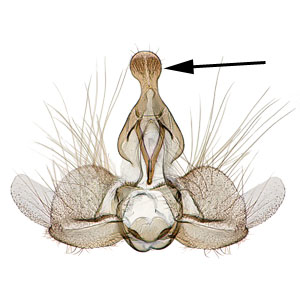 ; sociisocii:
; sociisocii:
a pair of lightly sclerotized setose lobes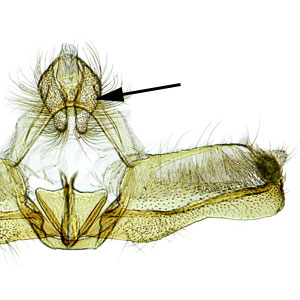 large; valvaevalvae:
large; valvaevalvae:
plural of "valva" large, broad. Female genitalia characterized by a ring-like sterigmasterigma:
large, broad. Female genitalia characterized by a ring-like sterigmasterigma:
the sclerotized region surrounding the female ostium bursae 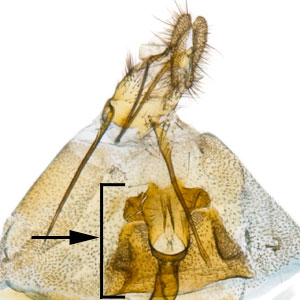 ; some sclerotization of the ductus bursaeductus bursae:
; some sclerotization of the ductus bursaeductus bursae:
a membranous tube connecting the ostium bursae to the corpus bursae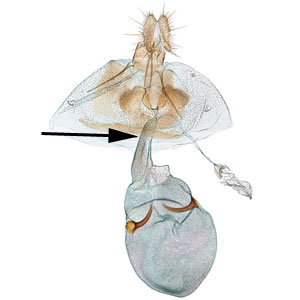 ; and two tack-like signasigna:
; and two tack-like signasigna:
plural of "signum"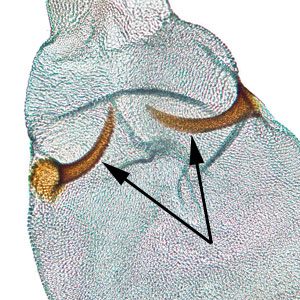 in the ductus bursaeductus bursae:
in the ductus bursaeductus bursae:
a membranous tube connecting the ostium bursae to the corpus bursae .
.
The following account is summarized from MacKay (1959)MacKay (1959):
MacKay, M. R. 1959. Larvae of the North American Olethreutidae (Lepidoptera). Canadian Entomologist, Supplement 10: 1-338..
Mature larva approximately 7 mm in length; width of head 0.9-1.1 mm; head yellowish-brown; prothoracic shieldprothoracic shield:
a sclerotized plate on the dorsal surface of the prothorax 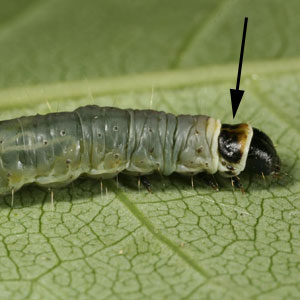 brown or yellowish-brown with brown laterallateral:
brown or yellowish-brown with brown laterallateral:
to the side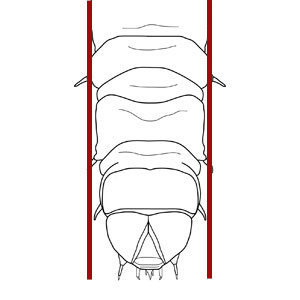 pigmentation; legs and anal shieldanal shield:
pigmentation; legs and anal shieldanal shield:
a sclerotized plate on the dorsal surface of the last abdominal segment (in larvae) 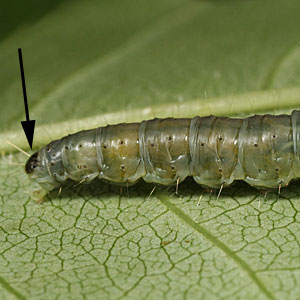 brown; body, pinaculapinacula:
brown; body, pinaculapinacula:
flattened sclerotized plates on a caterpillar that bear the setae yellowish; anal fork absent; SV group on A1, 2, 7, 8, 9 typically 2:2:2:2:1.
yellowish; anal fork absent; SV group on A1, 2, 7, 8, 9 typically 2:2:2:2:1.
Detailed figures of larval chaetotaxychaetotaxy:
the arrangement of setae (in reference to Lepidoptera larvae), often depicted on a "setal map"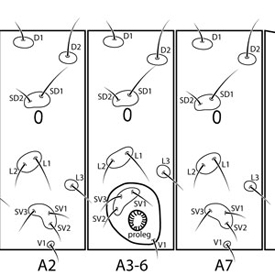 are available in MacKay (1959)MacKay (1959):
are available in MacKay (1959)MacKay (1959):
MacKay, M. R. 1959. Larvae of the North American Olethreutidae (Lepidoptera). Canadian Entomologist, Supplement 10: 1-338..
Gypsonoma haimbachiana could be confused with other species of Gypsonoma such as G. salicicolana, which is a smaller willow-feeding species (FWL: 4.5-5.5 mm) and has a more brown forewing in addition to differences in the genitalia. Adults of G. haimbachiana are also remarkably similar in FW pattern to Rhopobota finitimana, a smaller holly-feeding species. The genitalia of both sexes are quite distinct.
The following account is summarized from Morris (1967).
In the Mississippi Delta, eggs are laid on the upper surface of the leaves of the host plant, usually along the midrib. Eggs hatch in approximately five days at which point the young larva spins a small silken shelter and tunnels into the midrib or a major vein of the leaf. The larva molts into the second instar approximately three days later, abandons this first shelter and tunnels into a tender twig tip. The larva feeds in one or two twig tips for approximately three weeks and emerges as a fifth instar larva to move down the tree onto bark or to the ground to pupate. The adult moth emerges approximately eight or nine days later. Adults only live for five to ten days. A complete life cycle is completed in approximately 40-45 days. There are several generations per year; overwintering occurs as a second star instar in a bark crevice or hollowed out bud. Adults can be found from approximately May to September in most areas, but the flight window is longer in Florida and Texas, approximately April to October.
The primary host is eastern cottonwood (Populus deltoides), but larvae have been less commonly reared from other species of Populus.
| Host plant | Host plant family | Reference(s) |
| Populus balsamifera | Salicaceae | Prentice 1966Prentice 1966: Prentice, R. M. 1966. Vol. 4. Microlepidoptera. In : Forest Lepidoptera of Canada recorded by the Forest Insect Survey. Dept. For. Canada Publ. 1142: 543-840. |
| Populus deltoides | Salicaceae | MacKay 1959MacKay 1959: MacKay, M. R. 1959. Larvae of the North American Olethreutidae (Lepidoptera). Canadian Entomologist, Supplement 10: 1-338.; Morris 1967; Miller 1987aMiller 1987a: Miller, W. E. 1987a. Guide to the Olethreutine moths of midland North America (Tortricidae). USDA Forest Service Agriculture Handbook 660: 1-104.; Solomon 1995Solomon 1995: Solomon, J. D. 1995. Guide to insect borers in North American broadleaf trees and shrubs. Forest Service Agriculture Handbook AH-706, USDA, Washington, D.C. 735 pp. |
| Populus tremuloides | Salicaceae | Godfrey et al. 1987Godfrey et al. 1987: Godfrey, G. L., Cashatt, E. D., Glenn, M. O. 1987. Microlepidoptera from the Sandy Creek and Illinois River Region: A annotated checklist of the suborders Dacnonypha, Monotrysia, and Ditrysia (in part) (Insecta). Spec. Publ. 7. Illinois Natural History Survey. |
| Populus sp. | Salicaceae | McMillan et al. 1998 |
View full screen host table here
Gypsonoma bolliana is broadly distributed in eastern North America, from Maine, southern Ontario, and Minnesota south to Florida and Texas. There are a few records from Colorado which require verification.